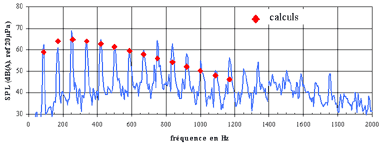Quiet, you old crates!
Onera is developing a propeller designed to reduce the noise from light aircraft without sacrificing performance or safety. Flight tests are planned for February 2008.
Number 21
 A propeller with 5 blades! Calculation has demonstrated that it’s the best compromise for minimizing noise pollution. |
The neighbours of Roissy and Orly airports are not the only ones to complain about aircraft noise. Those living close to aerodromes are not delighted either: light propeller-driven aircraft are particularly noisy for their size. They’re especially intrusive when used at the week-end, and when they repeatedly fly at low altitude. "Virtually all the small aerodromes are under pressure from residents associations who demand limits on flights and the noise they generate", says Claude Le Tallec, engineer at Onera and a flying enthusiast with more than 4,000 hours flying experience. |
|
European regulations still tolerate relatively high noise levels but Europe is considering a tightening up the controls. So Onera has been asked to look at what might be technically feasible in terms of reducing the noise levels of these light aircraft. Standards are defined, but no-one knows when they will come into force and become mandatory. At the moment, only one or two types of dual-blade propeller are approved on many light aircraft and they are quite noisy. And the flying clubs are not permitted to use quieter propellers for certification reasons.
However, sooner or later, manufacturers should be able to limit the noise from light aircraft. This is the aim of the Anibal program (Attenuation of the noise level of light aircraft), designed to reduce the nuisance caused by these small planes. Two sources of noise are more or less equivalent: the exhaust of the engine, and the propellers. For the first, solutions are already available. Three manufacturers offer quieter exhausts, simple and with no effect on aircraft safety. "For propellers, the matter is more complicated as any failure has dramatic consequences, and it is therefore difficult to modify a propeller and get it certified", explains the researcher. It is mainly the thickness noise (due to the thickness of the blade) and the load noise (due to the lift of the propeller) which generate the noise pollution. Furthermore, when the blades are long, the end moves more quickly and gets close to the sound barrier. So both the thickness and the diameter of the blades have to be reduced without loss of propeller performance. So Onera has designed a five blade propeller, of a smaller diameter than existing propellers, and made of composite materials so that thickness can be decreased. Resistance calculations are currently being done for models of this propeller, using a CAD software package (Catia). |
|
 The digital simulation, a stage in the design. Here the aerodynamics of the blades are shown, calculated using the elsA code. |
Onera expects to decrease the noise by at least 8 decibels with loss of performance limited to 3%. The models show a reduction of at least eight decibels, for neglible performance deterioration. It remains to be seen if these results are confirmed in full-size tests. " We have asked a specialist manufacturer, Duc-Hélices, to make two identical propellers" explains Claude Le Tallec. "One will be tested on the ground and will undergo ten times the number of tests that it would in flight. We will then be able to detect any possible problems. The other will be tested in flight. |
|
Four Onera departments are involved in the programme so that aerodynamic, acoustic and structural aspects can all be covered and both ground and flight tests carried out". The French Gliding Federation (FFVV) has loaned a towing airplane for the tests. ThThe flight tests are planned for February 2008, before the gliding season starts.
Cécile Michaut, scientific reporter. |
|
